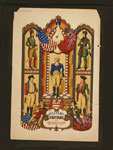National History Day in Kentucky
Question

Do you know where I can get a unit plan to teach National History Day that aligns with Kentucky Core Content for Assessment?
Answer
The theme for National History Day this year is “Revolution, Reaction, Reform in History.” The NHD guidelines ask students to consider the following questions: “What factors contributed to a revolution? Why was there a need to reform at the particular time? Why did this event cause a reaction?”
There’s plenty of revolution, reaction, and reform in American history (defining those terms with students may actually be a good place to start any unit that you design). So what kinds of things might you do that are covered in your state’s standards?
If you’re teaching elementary school students, consider a standard like Kentucky’s standard 1.3.1 for 5th graders:
“Students will explain the basic principles of democracy (e.g., justice, equality, responsibility, freedom) found in significant U.S. historical documents (Declaration of Independence, U. S. Constitution, Bill of Rights) and analyze why they are important to citizens today.”
Historical documents like the Declaration of Independence are evidence of a revolutionary thrust. And the U.S. Constitution, which established our current federal system, was a reaction to the Articles of Confederation that preceded it. Rounding out that trio of documents is the Bill of Rights, which Thomas Jefferson and others saw as a means of reforming the Federalist-inspired Constitution.
A similar standard is written for 8th graders, if you’re a middle school teacher interested in teaching about the nation’s founding documents. But you might also consider covering another topic like the American Civil War. Kentucky’s standard 5.2.4 for 8th grade is:
“Students will describe the political, social, economic and cultural differences (e.g., slavery, tariffs, industrialism vs. agrarianism, federal vs. states' rights) among sections of the U.S. and explain how these differences resulted in the American Civil War.”
The Confederacy’s secession from the union was a revolution of sorts, and the resulting Civil War was certainly a notable reaction. And you’d be hard-pressed to find a richer example of American reform than the period of Reconstruction after the Civil War, which, though it failed in a number of respects, brought the nation together again. So, once again, you have a lot of choices.
High school teachers have similar options for teaching. But again, you might consider a new topic or a new era. Kentucky’s standard 5.2.4 for high school, for instance, asks students to:
“explain and evaluate the impact of significant social, political and economic changes during the Progressive Movement (e.g., industrial capitalism, urbanization, political corruption, initiation of reforms), World War I (e.g., imperialism to isolationism, nationalism) and the Twenties (e.g., economic prosperity, consumerism, women’s suffrage).”
As with other examples, the Progressive movement was full of revolution, reaction, and reform. Examples listed, like women’s suffrage or the outbreak of World War I, as well as other examples like the temperance movement or the American socialist movement led by Eugene Debs would also make for interesting topics.
And, remember that in meeting the requirements for National History Day projects, you will also be meeting state standards for historical thinking. Kentucky’s standard 5.1.1 for 8th grade, for instance, asks students to use “a variety of tools (e.g., primary and secondary sources) to
describe and explain historical events and conditions and to analyze the perspectives of different individuals and groups.” Those are exactly the sorts of tools that National History Day organizers are looking to see.
You will likely need to craft your own unit, but a powerful lesson plan or two can go a long way in helping you do so. Resources like EDSITEment have content-rich plans on a number of relevant topics, including good ones on Reconstruction and the American Revolution. You can also search our website for lessons on a wide range of topics, including the Progressive Era. We also have some resources for integrating standards into your lesson plans, like this response to an earlier question.
